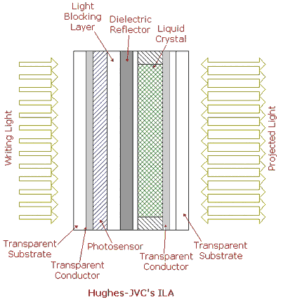Light Valve Amplifier (LVA) is a term used to describe a specific type of light valve developed by Hughes-JVC (Image Light Amplifier (ILA)).
An LVA is a device which uses the limited brightness of a small LCD to address a large area LC light valve that can modulate a large light source.
The light from the addressing display shines onto an array of photo-sensors which output an electric voltage varying in intensity to the brightness of the light which falls on them: the brighter the light, the higher the voltage. The voltage from each photo-sensor is directly coupled to the electrode which controls the corresponding pixel of the LCD panel which is being used as the light valve. In the case of the ILA, the relevant cell is immediately behind the light blocking layer which forms the back of the photo-sensor cell. The light valve now holds a duplicate of the source image and a very bright lamp can be used to project the image in the same way as in a normal light valve projector.
The ILA described is a rather early version of the device, later versions using fibre-optics to carry the source image directly from the CRT to the photo-sensors. Hughes-JVC has since developed a device called the D-ILA, which uses a CMOS chip, instead of a CRT and photo-sensors, to drive the light valve. This allows it to produce an image directly from a digital source and considerably reduces the size of the projector, because the bulky CRT is done away with.

